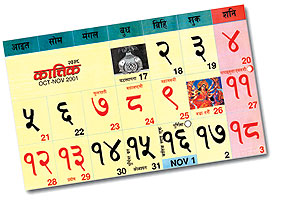 After the monsoon ends and autumn begins, the biggest thing is the biggest festival of the year. Just saying "Dasain" conjures images of windy days and blue kite-dotted skies, new clothes, plenty to eat and family gatherings that bring the entire clan together. Celebrated by a majority of Nepalis, the festivities mark the mythic battles between good and evil between goddess Durga and the demon Mahisasur. If he was living today, Mahisasur would be called a terrorist. The only difference is that he had taken on the form of a water buffalo. Dasain probably has pre-Vedic origins in harvest festivals and in a sense it has come a full circle to a cultural festival rather than a purely religious one. The longest holiday of the year provides the perfect opportunity for family reunions, and a time to relax.
After the monsoon ends and autumn begins, the biggest thing is the biggest festival of the year. Just saying "Dasain" conjures images of windy days and blue kite-dotted skies, new clothes, plenty to eat and family gatherings that bring the entire clan together. Celebrated by a majority of Nepalis, the festivities mark the mythic battles between good and evil between goddess Durga and the demon Mahisasur. If he was living today, Mahisasur would be called a terrorist. The only difference is that he had taken on the form of a water buffalo. Dasain probably has pre-Vedic origins in harvest festivals and in a sense it has come a full circle to a cultural festival rather than a purely religious one. The longest holiday of the year provides the perfect opportunity for family reunions, and a time to relax. Those who criticise us for having such a long holiday at Dasain must remember that Nepalis don't usually take vacations, so this is our holiday season. Dasain comes from the word for ten: ten days during the bright lunar fortnight ending on the day of the full moon-1 November this year.
17 October. Ghatasthapana, literally "pot establishing" (and we are not talking here about hallucinatory agents) marks the beginning of the festival. The kalash, water vessel is placed in the prayer room. A leaf plate filled with sand and covered with cow dung is shielded from the sun and placed in front of the image of the Durga. Barley seeds are sown unto the sand block and water from the kalash is sprinkled on it to nurture the seeds everyday during the morning and evening puja. The ritual performed at a certain auspicious moment determined by the astrologers will provide the yellowish green seedling known as jamara considered a blessing of Durga and bestowed by elders atop the heads of those younger to them during tika. The same ritual is also conducted at the royal palace in Gorkha, 169km north west of the valley where the ancestors of the present royal family started their conquest of Nepal in 1801.
From the days following Ghatasthapana to the seventh day pujas are offered everyday and regular rituals performed. On the fifth day the jamara to be used by the royal household planted in Gorkha palace is brought out and the procession for Kathmandu begins. The procession comes to Kathmandu on the seventh day bearing the Phulpati (23 October). Brahman priests carry the jamara and sugar cane plants tied with red cloth in a decorated palanquin under a gold tipped and embroidered umbrella. The procession also carries the royal kalash, banana stalks, and sugar cane tied with red cloth and includes Royal Nepal Army men wearing the same attire that Prithvi Narayan Shah's men wore. When the phulpati arrives in Kathmandu the procession starts from Rani Pokhari and ends in Basantapur Hanuman Dhoka Royal Palace where the jamara is placed in the Dasain Ghar.
24 October. Maha Asthami or the eighth day of the festival is the day when the goddesses Durga and Kali have to be appeased. Animal sacrifices of buffalo, goat, sheep, chicken and duck are made all over the country. The night of the eighth day is called Kal Ratri, the dark night. Hundreds of animals are sacrificed in Durga and Kali temples, palaces, and military barracks. Let the feasts begin.
25 October is Nawami. The Taleju temple at Hanuman Dhoka is opened for the public. This is the only day in which the temple is open and thousands throng the temple. Sacrifices are again held at Hanuman Dhoka Royal Palace to honour the Durga. This is also the day when Biswokarma, the god of creativity is worshiped. Factories, vehicles, machines household weapons, and these days even computers and jet airliners are worshiped.
After ten long days the battle is over and victory has been achieved, good prevails. 26 October is Dashami the tenth day. The day elders put jamara and tika upon the foreheads of those younger and bless them. The importance of Dasain also lies in the fact that this day brings family members and relatives from far and wide to receive tika from the head of the family. The king and queen too give tika to the hundreds waiting outside the palace thus strengthening the relationship. Tika continues for four days and in the last day people stay at home and rest. The full moon day is also called Kojagrata, meaning \'who is awake'. The goddess of wealth Laxmi is worshipped and people gamble the night away.


